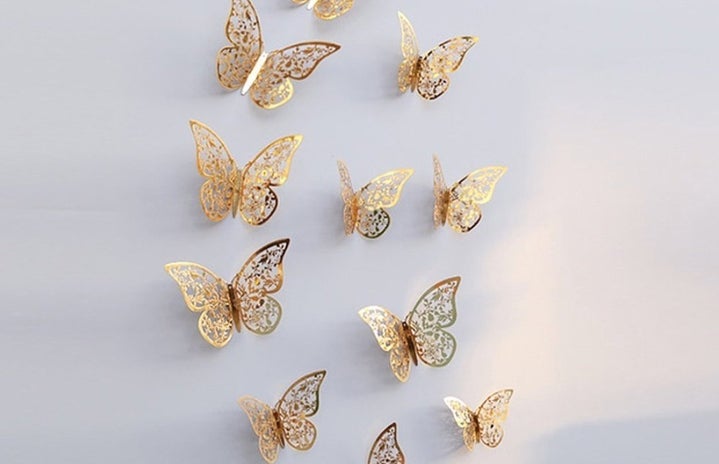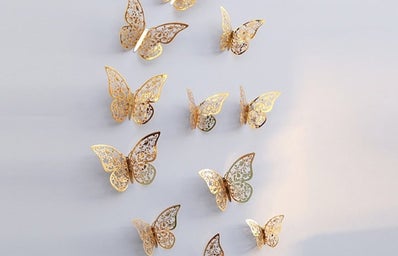Daylight dwindles and the cold creeps upon us. Borne upon windy skies, thousands of butterflies begin the long journey south, determined to reach warmer temperatures for a chance to live. With the delicate beauty of their wings, the butterfly is widely styled as a symbol of grace. Yet when viewed within the context of its migration—an environmentally treacherous voyage that requires enormous strength—the insect also becomes an emblem of perseverance.
In his massive sculpture Mariposa/Butterfly, Hector Dionicio Mendoza portrays the insect through a lens that blends power and elegance. Broad, sweeping wings extend in four quadrants from a driftwood thorax, which is topped with a large, muscular, metal hand, fingers tucked into a fist. The hand is coated in golden paint, which seems to trickle down its black forearm as though it is blood. Whose hand is raised here, and why is it raised in protest?
The two wings at the top are decorated with straight, multicolored streaks, directing our gaze toward the center of the artwork. The bottom wings, however, have tips adorned with the reverse silhouettes of plants; white impressions of flora are printed on a black surface, rather than black images surrounded by white. The simple, two-palette color scheme of the bottom wings contrasts the flamboyant polychrome of the top ones; another duality presented by Mendoza. Perhaps the streaks of color are meant to imitate the rays of the sun as they shine down upon the plants below, imbuing them with life.
As our gaze travels inward, our attention is interrupted by strange, mechanical holes of varying sizes, scattered within the inner plane of the wings. Some are completely hollow; others merely form the impression of a hole, but do not actually pierce through the surface. They appear almost industrial, as though they belong alongside the gears of a clock. Here, manmade innovation intersects with the natural qualities of the butterfly.
Perhaps the most compelling aspect of Mendoza’s sculpture is the ethnic bread that is baked within its skin. Mendoza, who was born in Mexico, used masa flour, a bread pulp similar to a tortilla, to decorate the inner portions of the wings as they come together at the wooden thorax. The decoration, along with the mechanical holes, provides the wings with a rich texture that is amplified by the rough-hewn surface of the wood. The butterfly is not flat or one-dimensional, but rather, complex and multilayered.
Power, beauty, complexity. These qualities, embodied in Mendoza’s sculpture, suggest a larger theme surrounding the immigrant experience in the Americas. The monarch butterfly has been claimed by proponents of the Deferred Action for Childhood Arrivals program and has come to represent the journeys of thousands of immigrants to the United States. It describes immigration as a beautiful, transformative, and hopeful act for thousands of people. Simultaneously, it recognizes the necessary strength and tenacity of immigrants when attacked by political barriers and xenophobic intolerance.
Mendoza’s inclusion of blended materials celebrates the cultural diversity of immigrants, while his artistic union of dualities recognizes that the immigrant experience is not monolithic. Every migrant has their own story, their own hardships, their own journey; each something to be cherished as a crucial part of one’s identity.
Today, Mariposa/Butterfly is on display at the Mount Holyoke College Art Museum, mounted on a wall that faces the entrance. For the curious art enthusiasts who enter, it is likely to be the first work in the collection that they notice, and with its multifaceted complexities, it most certainly deserves this honor. The work was selected for curation by Vanessa Rosa, Assistant Professor of Latino/a Studies, and David Hernandez, Associate Professor of Latino/a Studies, of Mount Holyoke College.
If you would like to write for Her Campus Mount Holyoke, or if you have any questions or comments for us, please email hc.mtholyoke@hercampus.com.

